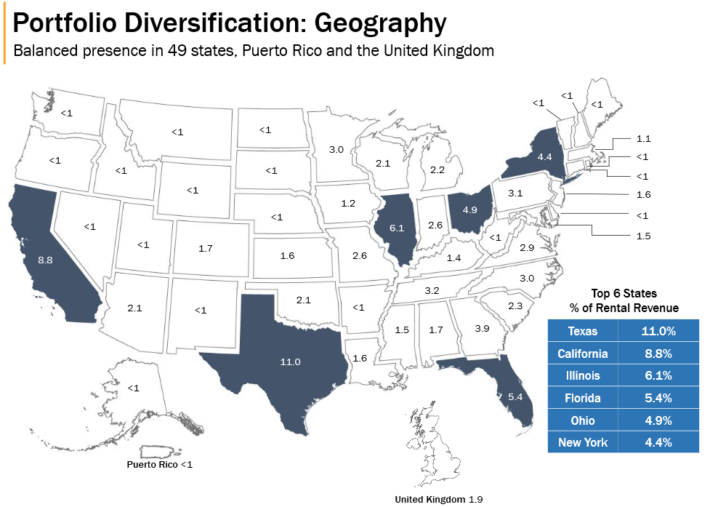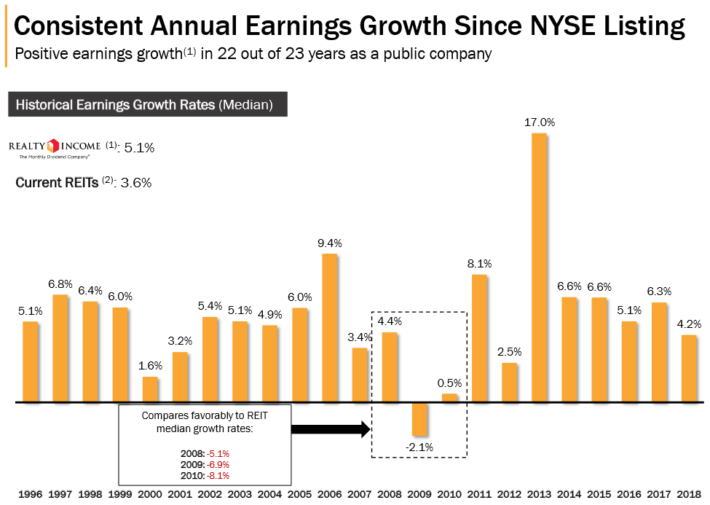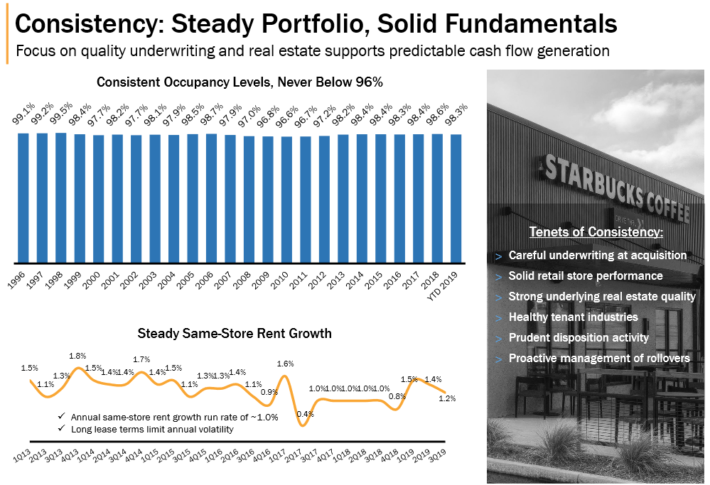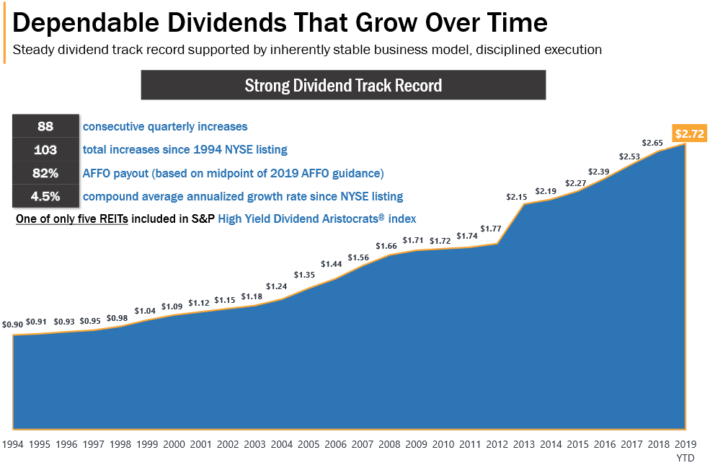Updated on February 11th, 2020 by Samuel Smith
When it comes to dividend growth stocks, the Dividend Aristocrats are the “cream of the crop”. These are stocks in the S&P 500 Index, with 25+ consecutive years of dividend increases. This is why we recommend long-term investors looking for the best stocks, first consider the Dividend Aristocrats.
We have compiled a list of all 64 Dividend Aristocrats, along with relevant financial metrics like dividend yield and P/E ratios. You can download the full list of Dividend Aristocrats by clicking on the link below:
At the same time, Real Estate Investment Trusts (REITs) seem like natural fits for the Dividend Aristocrats. REITs are required to distribute at least 90% of their earnings to shareholders, which leads to steady dividend growth for the asset class, provided earnings grow over time.
And yet, there are only three REITs on the list of Dividend Aristocrats: Federal Realty Investment Trust (FRT), Essex Property Trust (ESS), and Realty Income (O). The reason for the relative lack of REITs in the Dividend Aristocrats Index is primarily due to the high payout requirement of REITs. It’s difficult to grow dividends year-in-and-year-out when the bulk of income is being distributed, as this leaves little margin for error.
Realty Income has a very impressive dividend history, particularly for a REIT. Realty Income has increased its dividend for 25 years in a row, enabling it to recently join the list of Dividend Aristocrats. It is also a monthly dividend stock, meaning it pays shareholders 12 dividends each year instead of the more typical quarterly payment schedule.
This article will discuss this brand new Dividend Aristocrat in more detail.
Business Overview
Realty Income was founded in 1969 and is headquartered in San Diego. It is a retail focused REIT that has become famous for its successful dividend growth history and monthly dividend payments, even labeling itself “The Monthly Dividend Company.” The trust employs a highly scalable business model that has enabled it to grow into a massive landlord of more than 4,000 properties with a market cap of $25 billion.
While many retail landlords are struggling in the age of Amazon (AMZN) and e-commerce, Realty Income continues to thrive because it owns retail properties that are not part of a wider retail development (such as a mall), but instead are standalone properties. This means that the properties are viable for many different tenants, including government services, healthcare services, and entertainment.
In fact, Realty Income owns a highly diversified portfolio by industry, tenant, and geography. Approximately 96% of its rent comes from e-commerce and recession resistant tenants, making it a good bond substitute. The company also has exposure to industrial, office, and agricultural tenants, though retail does make up the vast majority (82.7%) of its rental income. The company derives rental income from all over the United States as well as the United Kingdom, insulating itself against regional challenges.
Source: Investor Presentation
The REIT’s business model is quite simple and has delivered spectacular long-term results. Realty Income acquires well-located commercial properties, remains disciplined in acquisition underwriting, executes long-term net lease agreements, and actively manages the portfolio to maximize value. It also maintains a conservative balance sheet with a laser-like focus on growing funds from operations (FFO) per share and monthly dividend payments to investors.
The results of this model speak for themselves: 16.8% compound average annual total return since the 1994 listing on the New York Stock Exchange, a mere 0.4 Beta against the S&P 500, growing cash flows per share in 22 out of its 23 years, achieving a 93.8% adjusted EBITDARE Margin, and having one of the few A- credit ratings among U.S. REITs. It is now one of only two U.S. REITs to sport both an A- credit rating and boast the dividend growth track record of being a Dividend Aristocrat.
Growth Prospects
The trust’s growth history is remarkable as evidenced by the following chart:
Source: Investor Presentation
Annual growth – fueled by slow but steady annual rent hikes and a consistently strong acquisition pipeline – has been very consistent across economic cycles, making it a spectacular dividend growth stock.
Realty Income’s future growth will be fueled by its proven, highly scalable business model, access to significant low-cost capital, and extensive network of relationships with a diverse array of tenants. The biggest challenges facing management are that it has already reached such a massive size, making it increasingly challenging to find enough acquisitions to effectively move its growth needle without sacrificing quality. In addition, cap rates are becoming increasingly compressed.
Annual rent increases are very low at only ~1%, making organic growth very slow. As a result, it must find a way to continue acquiring enough properties to keep moving the needle in a meaningful risk-adjusted way despite its massive size and compressing cap rates.
The good news is that its low cost of capital (via share issuances above net asset value and low interest rates thanks to its A-rating) enable it to accretively deploy capital despite compressing cap rates. However, if management fails to continue this effort, investors may very well be in for significant multiple contraction to adjust for declining growth expectations.
In the most recent quarter, Realty Income showed that it is still able to source large needle-moving acquisitions as it announced the execution of a $1.25 billion transaction at a cash cap rate of 7%, which is quite healthy considering their very low cost of capital and conservative business model. While economic occupancy fell by 130 basis points on a year over year basis, it still held strong at 97.8%. Plus, contractual rent growth increased by 1.2%, well above the normal 1% level. However, re-leasing spreads were fairly lackluster at 1.5% and same-store net operating income grew by 1.2%.
As of quarter end, about half (49%) of rental revenue came from investment grade tenants, which should rise as the $1.25 billion acquisition will have 58% of rental revenue coming from investment grade tenants. The quality and value unlocked through this large deal reflects the power of Realty Income’s broad network and attractive cost of capital.
Competitive Advantages & Recession Performance
One way in which REITs establish a competitive advantage is through investing in the highest-quality portfolios. Realty Income has done this by building a broadly diversified portfolio of well located real estate with many high quality tenants.
Realty Income also benefits from a favorable economic backdrop, with high occupancy rates, and the ability to raise rents over time.
Another – and perhaps the biggest – competitive advantage for Realty Income is its extremely strong balance sheet. With a credit rating of A- from Standard & Poor’s – which is solidly investment-grade and a high rating for a REIT – it is able to unlock value in large acquisitions simply through refinancing the existing debt on the properties it acquires at considerably lower interest rates.
As a result, it is able to profitably invest in high-quality assets that many of its competitors could not. This gives it the ability to build a stronger portfolio while also having more growth levers available to it, generating superior risk-adjusted returns for shareholders.
As history has shown, these competitive strengths allow Realty Income to outperform well during the worst of economic recessions. For example, its FFO per share during the Great Recession (from 2007-2009) grew at an annualized rate of 2.1% and its occupancy remained highly resilient throughout the entire period.
Source: Investor Presentation
This was a remarkable achievement, and speaks to the strength of the business model. We expect Realty Income to hold up similarly well during the next downturn, and in fact it will likely present the trust with an opportunity to refuel its growth pipeline as it will likely use its strong balance sheet to snatch up discounted properties.
Valuation & Expected Returns
Based on our expected 2019 adjusted FFO-per-share of $3.32, Realty Income’s stock trades for a price-to-FFO ratio of 24.1. Investors can think of this as similar to a price-to-earnings ratio.
On a valuation basis, Realty Income appears considerably overvalued. The trust has generally traded with a price-to-FFO ratio in the high teens, and we expect it will again once interest rates normalize back towards historic levels. Should the stock return to our forecast fair value of 17 times FFO, it would provide a ~6.7% headwind to annualized total returns. Realty Income has spent much of the past year trading between $70 and $80 per share, which is well above our fair value estimate of $56.
Therefore, future returns will be comprised of a mix of FFO growth (~5% annually) and dividends (current yield is ~3.5%), though we expect this will be largely offset by multiple contraction. In this scenario, total returns would be roughly 1.5% annually, as the trust would suffer from significant multiple contraction.
The current dividend yield of 3.5% is a pretty average yield for a REIT, as is its growth outlook. That being said, Realty Income helps make up for some of this unimpressive forward outlook with its strong management and balance sheet as well as its impeccable dividend growth track record.
Source: Investor Presentation
However, Realty Income’s dividend yield has fallen over the past decade, as its share price gains have exceeded its dividend growth rate. As a result, Realty Income stock presents a fairly unattractive valuation and dividend yield, compared with historical levels.
Final Thoughts
Investors flock to REITs for dividends, and with high yields across the asset class, it is easy to see why they are so popular for income investors.
We have compiled a list of 150+ REITs, that are worthy of further consideration, based on their dividend yields and dividend growth potential. You can see all 150+ REITs here.
Realty Income is quite overvalued at present and offers investors meager total return potential. While long-term conservative dividend growth investors may want to hold on to it, we overall rate it a sell simply due to valuation.









